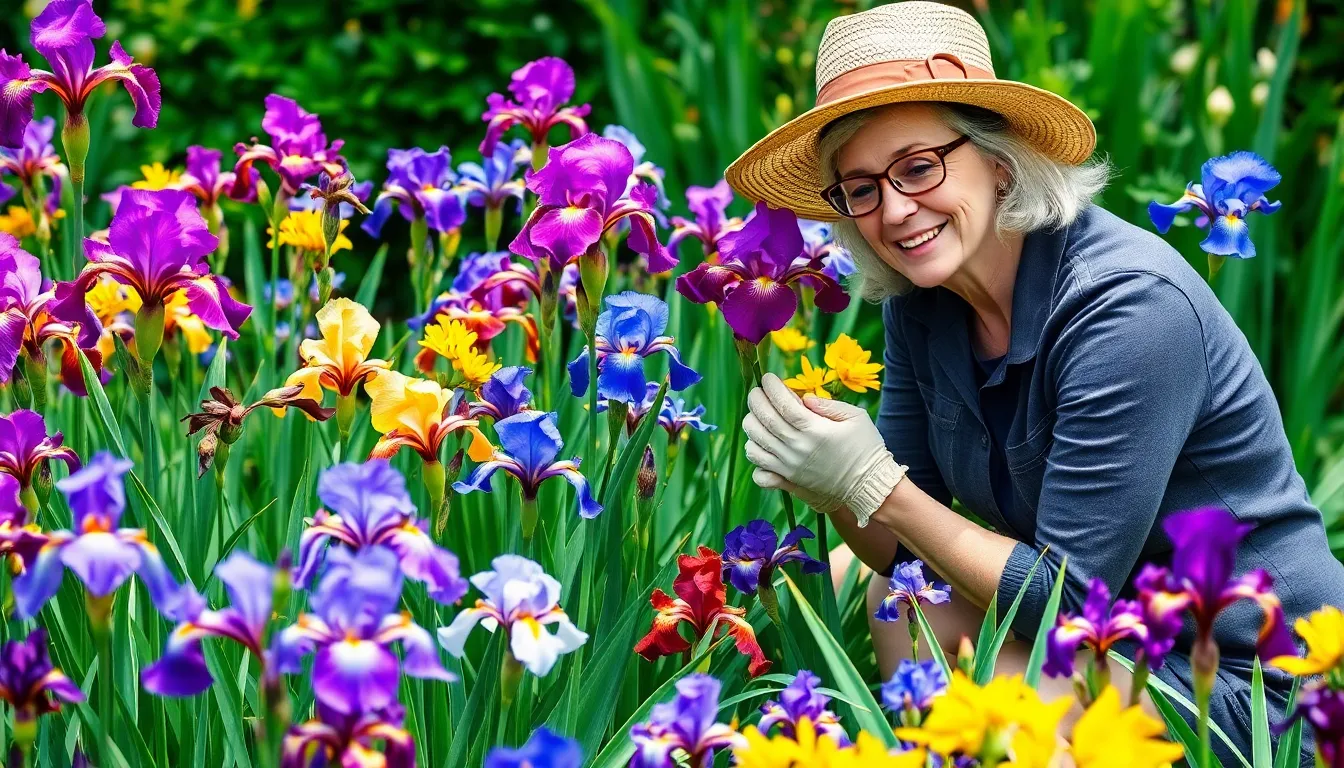Iris plants are like the divas of the garden—stunning, vibrant, and a bit demanding. If you want your irises to strut their stuff and bloom like they mean it, a little TLC goes a long way. With their striking colors and unique shapes, these beauties can turn any dull corner into a floral masterpiece, but only if you know how to pamper them just right.
Iris Plant Care
Iris plants stand out as stunning additions to any garden. Known for their unique shapes and vibrant colors, these blooms require careful attention for optimal growth.
Types of Iris Plants
Numerous varieties of iris exist, each showcasing distinct features. Bearded iris plants possess ornate petals and thrive in well-drained soil. Siberian iris plants boast narrower leaves and resist pests, making them low-maintenance options. Japanese iris plants display large flowers that flourish in damp areas, providing beautiful visual appeal. Each type brings unique aesthetics and adaptability to various gardening environments.
Benefits of Growing Iris
Growing iris plants offers many advantages. These flowers attract pollinators, enhancing biodiversity in gardens. They also provide vibrant visuals, blooming in various colors that uplift dull spaces. Iris plants tolerate drought, making them suitable for varied climates. Their long-lasting blooms, which can last several weeks, ensure continual beauty throughout the growing season.
Essential Iris Plant Care Tips

Caring for iris plants requires attention to specific needs. Following these essential tips ensures optimal growth and stunning blooms.
Soil Requirements
Soil quality plays a crucial role in the health of iris plants. Well-draining soil is essential to prevent root rot. A mix of sandy loam, organic matter, and good drainage promotes healthy growth. Soil pH should range from 6.0 to 7.0 for ideal nutrient uptake. Adding compost enriches the soil while improving its structure. Testing the soil before planting helps identify adjustments needed for optimal conditions.
Watering Guidelines
Watering practices significantly affect iris vitality. During the growing season, irises require consistent moisture but must not sit in water. Soaking the soil once a week encourages deep root development. Allowing the soil to dry slightly between waterings prevents issues like rot. Newly planted irises benefit from more frequent watering until established. Observing the weather can guide adjustments for rainfall, ensuring irises remain hydrated.
Light Conditions
Light exposure influences iris growth and flowering. Most iris varieties thrive in full sun, requiring at least six hours of direct sunlight daily. Some types, like Japanese irises, tolerate partial shade, making them versatile for garden placement. Proper light conditions enhance blooming and prevent leggy growth. Observing the sunniest areas of the garden can help in selecting the best spots for planting irises. Regular monitoring of light conditions ensures these plants flourish magnificently.
Common Pests and Diseases
Iris plants can face various pests and diseases that threaten their health and beauty. Identifying these issues early helps maintain a vibrant garden.
Identifying Pests
Aphids often cluster on young shoots and flower buds, making them easy to spot. These small, green or black insects cause stunted growth and distorted leaves. Slugs and snails present a different challenge, leaving slimy trails and holes in foliage. Thrips also affect irises by causing streaks on flowers and leaves. Fungal infections, such as root rot or leaf spot, can also occur and lead to yellowing or wilting. Regular inspection aids in quick identification, allowing for timely intervention.
Treatment Options
Insecticidal soap effectively manages aphids and thrips, providing a safe treatment option. Bait traps or barriers can deter slugs and snails, protecting vulnerable plants. For fungal issues, applying fungicides or improving air circulation around the plants significantly reduces infection risk. Removing affected leaves and avoiding overhead watering further helps prevent disease spread. Implementing these treatment strategies maintains the health of iris plants, ensuring they remain stunning in the garden.
Best Practices for Seasonal Care
Iris plants benefit from specific seasonal care to ensure vibrant blooms and healthy growth throughout the year.
Spring Care
Spring marks the ideal time to rejuvenate iris plants. Begin by cutting back any dead foliage to encourage new growth. Soil should receive attention, ensuring it’s well-draining and enriched with compost. Fertilizing with a balanced formula supports lush foliage and abundant blooms. Watering should occur regularly, keeping the soil consistently moist but not soggy. Monitoring temperatures helps to prevent frost damage, particularly in early spring. Observe for signs of pests, as early intervention safeguards plant health.
Fall Preparation
Preparing iris plants for fall is crucial for their survival during winter. Begin by trimming spent blooms and yellowing leaves, allowing energy to focus on root development. Digging up bulbs becomes necessary in some climates prone to frost, while those in milder zones may remain in the ground. Providing a layer of mulch helps insulate roots from cold temperatures. Watering should reduce as growth ceases, preventing excess moisture that could rot bulbs. Assessing garden areas for pests and diseases ensures the health of the plants going into dormancy.
Conclusion
Caring for iris plants is a rewarding endeavor that brings stunning visuals and vibrant life to any garden. With the right attention to soil quality light exposure and pest management these flowers can thrive and bloom beautifully season after season. By following the essential care tips and seasonal practices outlined gardeners can ensure their irises not only survive but flourish. Embracing the unique characteristics of different iris varieties adds depth and diversity to garden landscapes making them a worthwhile addition for any plant enthusiast. With a bit of TLC iris plants will undoubtedly transform outdoor spaces into breathtaking floral displays.




